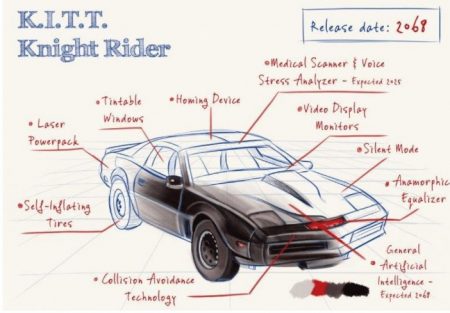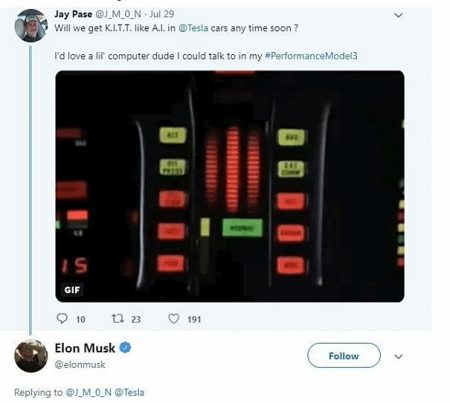January 18, 2019 – Today’s blog contribution comes from Leasing Options and the desk of Lou Crane. Self-inflating tires, hydrogen fuel processors and collision avoidance technology were once just figments of movie-writers imaginations. But here we are in 2019, and all these technologies now exist. I imagine, like many other movie-goers, the first time you ever watched Minority Report, I Robot or Blade Runner you wondered if, one day, you would own such a super-car. Well in this piece Leasing Options, a UK company shows us just how close and how far we are from developing the high-tech and seemingly impossible features of some of the world’s most popular sci-fi cars. With the help of some experts, we have predictions on when some of these cool features will be commercially available.
When Knight Rider aired on television from 1982 to 1986 it introduced a car called KITT. KITT could talk, think, and help solve crimes. With current advancements in car technology moving us towards autonomy it seems a perfect time to try and figure out when we will see cars like KITT on our roads?
KITT isn’t the only sci-fi car phenomenon we have been introduced to through the movies and television. There are all those James Bond cars, and there is the Audi RSQ from I, Robot, the Lexus 2054 from Minority Report, and the Spinner, from Blade Runner.
In this posting, we will leave out the Bondmobiles and look at the features of four of these futuristic vehicles beginning with KITT and gauge what is reality today and what features are still in our future. Not every feature of KITT or any of these other cars is practical, desirable or even legal. So, we’ll try and focus on each of the car’s most important features and figure out if we have them now or when if ever, they might become available.
KITT – Expect A Release Date of 2068 for Its Equivalent

Looking at KITT we can see that much of the technology demonstrated in Knight Rider now exists. And, in fact, we are even seeing that KITT features have been surpassed by current cars. But the artificial intelligence built into KITT is still something far in our future.
KITT was given artificial general intelligence (AGI). Elon Musk, creator of Tesla and SpaceX, has been upfront about wanting to create a car that utilizes A.I. When asked on Twitter about creating a car with KITT intelligence, he replied “I’d love a lil‘ computer dude I could talk to in my #PerformanceModel3.”
Sadly, a computer dude with AGI performing at the same intellectual level as a human is still a distance away. A 2018 survey of experts, when asked about when AGI will become a reality, came up with a range of between 21 and 50 years in our future. That would mean a KITT could exist as early as 2039 or as far in the future as 2068.
KITT also featured an anamorphic equalizer which was based on the iconic Cylon visor seen in Battlestar Galactica. The equalizer served as KITT’s eyes allowing the car to see in the infrared and x-ray spectra. Cars using infrared already exist. The Cadillac DeVille introduced this feature in its year 2000 model. But as for x-ray vision, that’s probably never going to be needed for commercial vehicles. Perhaps it can be a mod?
KITT also featured silent drive mode to sneak up on the bad guys. Today electric cars approach complete silence and in fact, they are so quiet that lawmakers are requiring manufacturers to make them create fake noise so that pedestrians are aware of them when approaching from behind.
And then there is KITT’s homing beacon. Unsurprisingly, Google has already incorporated this feature into its driverless cars.
The laser powerpack in KITT also has become a reality but not for cars. The United States Navy has in its arsenal a laser weapon that can destroy boats, drones, and burn holes in enemy warships.
KITT also featured a medical scanner and voice stress analyzer. It could tell if its operator was okay, if he had been poisoned or if he was suffering from some other medical emergency condition. Expected to become a feature in cars by 2025, Ford has already introduced the ECG Heart Rate Monitoring Seat with six embedded sensors to measure a driver’s vital signs. By 2025 it is expected that advanced biometrics will be incorporated into cars to track a driver’s stress levels, brain waves, fatigue, and even facial expressions, giving the vehicle early indicators if anything is wrong to require the car to intervene in its operations.
KITT’s tintable windows that could go from transparently clear to impenetrable is today a reality. The technology can be found in automotive supplier, Continental, who at the push of a button provide Intelligent Glass Control. Of course, with AGI the car could do this automatically.
As for self-inflating tires featured in an episode of Knight Rider, (the tires could also deflate), this technology exists today. SIT stands for Self-Inflating Tire, a technology developed by CODA in the Czech Republic. It uses the energy of the wheel to self-inflate a tire to keep its pressure optimal.
KITT’s engines were powered by hydrogen. Toyota’s model, the Mirai, was released in 2015, the first commercial hydrogen car. And KITT wasn’t limited to hydrogen as its energy source. It could get power from alternatives making it effectively a hybrid. Well, you know that hybrid vehicles are very much on the road these days with Toyota the leader in this technology.
KITT also featured two video display monitors to help in crime fighting. Today’s police cars have at least one in addition to a video display screen built into the vehicle by the manufacturer. It almost makes KITT’s displays seem like antiques when you look at the arrays and heads up display technology in cars right now.
KITT featured collision avoidance technology. This is technology that has been in existence since first demonstrated by scientists in 1995 at Hughes Research Laboratories in California.
KITT also came with gadgetry and gimmicks we will never see in standard vehicles: a seat ejection system, a flamethrower, a money dispenser, and even the ability to jet over water. Those are features to be left in sci-fi, and not reality. Although the laser powerpack will never make it to the street, we left it in because lasers are cool.
In our next installment, we’ll look at the sci-fi technology in the Audi RSQ of I,Robot. So stay tuned to more on sci-fi cars versus reality.
















